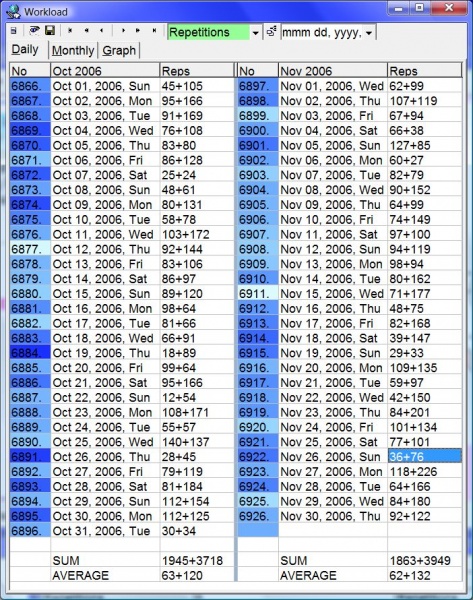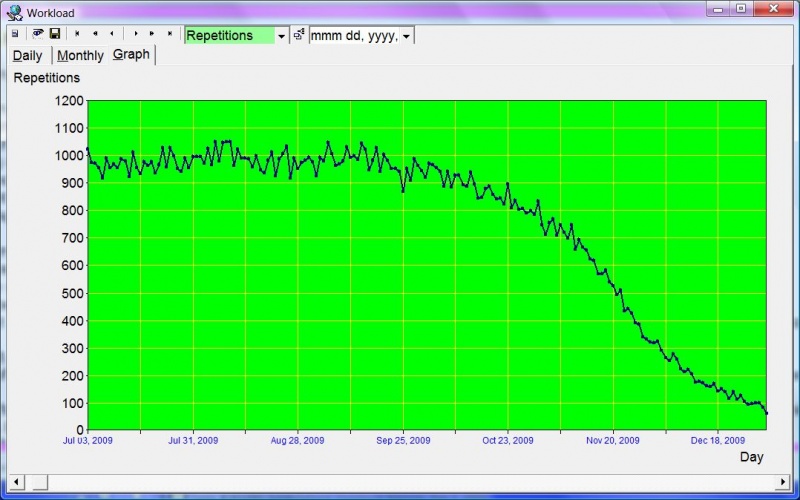Contents |
Tools : Workload (Ctrl+W) can be used to inspect:
- the number of elements scheduled for review on individual days or months in the future (and which these elements are)
- the number of elements reviewed in the past on individual days or months (and which these elements are)
- daily retention and consolidation data
and more.
Workload toolbar
- Local menu - open the Workload menu otherwise available with a right-click over the Workload window
- View selected entry (Enter) - browse elements scheduled or reviewed on a given day
- Save data to an Excel file - save the Workload data to a CSV file (importable to Excel, for example, for further analysis)
- Go to the beginning of the schedule - go to the panel with the first scheduled or executed element
- Move 4 panels back - go 4 panels back
- Move 1 panel back - go 1 panel back
- Move 1 panel forward - go 1 panel forward
- Move 4 panels forward - go 4 panels forward
- Go to the furthest scheduled element - go to the panel with the latest scheduled element
- Display mode combo box
- Workload - display how many items and topics are scheduled on individual days or months (displayed as "items+topics")
- Items only - display how many items are scheduled on individual days or months
- Topics only - display how many topics are scheduled on individual days or months
- Retention - display the record of past retention (displayed as "retention -> consolidation" or as retention where no consolidation data is available)
- Repetitions - display the record of past repetitions (displayed as "items+topics")
- New items - display how many new items were memorized on individual days
- Next display mode - change the display mode to the next available (e.g. Topic only if Items only is currently selected)
- Date format combo box - makes it possible for you to change the format of dates displayed in the Workload window to the one you prefer
- Default (e.g. 5/4/2009, Mon)
- Full (e.g. May 04, 2009, Mon)
- Classic (e.g. 5/4/2009)
- Weekday (e.g. 04 - Mon)
- Simple (e.g. 04 May)
Right-click over the workload window opens the workload menu:
- Daily workload (Alt+D) - switch to daily workload view
- Monthly workload (Alt+M) - switch to monthly workload view
- Workload graph (Alt+G) - switch to workload graph view
- View (Enter) - switch from monthly view to the selected month of the daily view (when in monthly view) or browse through future or past repetitions scheduled for or executed on a given day (when in daily view)
- Switch panels (Ctrl+Tab) - switch between view panels (from daily to monthly, from monthly to graph, from graph to daily, etc.)
- Export data - export past and future workload into an Excel file
- Close (Esc) - close the workload window
Workload tabs
Daily workload
In the picture above, the record of repetitions executed over a two-month period in October and November of 2006. Additionally, Daily workload tab displays the Monthly total, as well as the Daily average. Note that the number of executed repetitions in the workload may differ from the number of elements in the history subset for that day (e.g. opened by pressing Enter on a selected entry). For example, the same element can be memorized and reset more than once. However, it will appear only once in the history subset. Depending on the operation, elements may or may not register in the history subset. For example, cloze deletions produced by Decompose will register on the assumption that you cannot execute Decompose without first reviewing the decomposed phrase. However, Dismember will not register child elements. For example, you might have just dismembered a page with multiple pictures without having time to review those pictures.
Monthly workload
In the presented picture, the record of repetitions executed over a three-year period (i.e. the years: 2005, 2006, and 2007). Additionally, Monthly workload tab displays the Annual total, as well as Monthly and Daily (items + topics) averages.
Workload graph
In the presented picture above, the number of elements scheduled for repetition/review from Jul 03, 2009 onward until the end of the year.
FAQ
Colors in the Workload window
From: Robert Drozd
Country: Poland
Sent: Tuesday, November 05, 2002 12:49 PM
Question
What do the colors in the Workload window mean?
Answer
Color intensity is used to correlate retention and repetition count (only in Daily).
If you look at Retention, ignore lighter fields, which indicate little data collected. Darker fields mean solid/reliable data.
If you look at Repetitions, darker fields indicate good retention, while lighter fields show sloppy days.
Using these colors you can also get an overview of repetition intensity in a month and retention level in a given month
Workload displays each item once
From: Eric E.
Sent: Feb 10, 2007, 08:33:18
Question
When I select Tools : Workload, the workload indicates I will be doing repetitions over the next few weeks, but never again after that. I advanced the workload calendar forward over a 20 year period, and no further repetitions are scheduled. Is this expected?
Answer
Yes. Workload displays each item once. Items show up on the day on which they are expected to be reviewed. Workload does not display predictions on future repetitions of those items. It is possible to predict the average outcome of the learning process. However, it is impossible to predict the outcome for each case. This is why Workload displays scheduled repetitions, instead of trying to predict all possible future repetitions.





